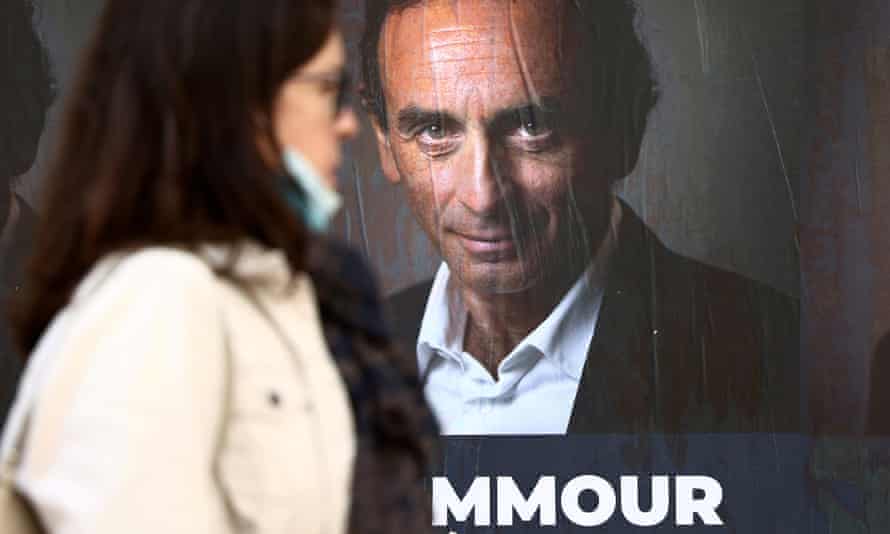With just months to go before presidential polls, the centre-right Les Républicains, under pressure from both flanks, are scrambling for a suitable candidate

Kim Willsher in Paris
Sun 17 Oct 2021
Six months before a presidential election and France’s mainstream right finds itself squeezed – between the hammer and the anvil as they say here – without a candidate and facing an existential threat from either side.
On one flank are the far-right Marine Le Pen and Éric Zemmour, a polarising television pundit who wants to talk about immigration, identity and Islam – the three i’s – and ban “non-French” names such as Mohamed.
On the other is Emmanuel Macron, a self-declared “centrist” president who, nearing the end of a five-year mandate marked by the Covid epidemic, needs to woo centre-right voters to stay in power.
As Zemmour, who has been nicknamed the French Trump, dominates the airwaves hammering home his message, polls suggest if he stands either he or Le Pen will be facing Macron in the second round run-off.
Where does this leave the mainstream Les Républicains (LR), the traditional heirs of General de Gaulle and his “certain idea of France”, now faced with Zemmour’s accusations it has betrayed its hero and become a party of chochottes or French “snowflakes”?
In previous years, the centre right has put on a show of unity, however fragile, in presidential races. In 2017, after a fiercely contested primary, the party rallied behind François Fillon, a shoo-in as the next president until historical scandals caught up with him.

Macron came from nowhere with his “neither right nor left” mantra, siphoned votes from both mainstream parties and destroyed the political alternance that had seen the Parti Socialiste (PS) or the centre-right party take power.
Five years on, the PS candidate, Paris mayor Anne Hidalgo, is trailing badly in the polls, while LR is engaged in a frantic race against the electoral clock to paper over the cracks before next April. A poll of LR’s 80,000 members has been postponed until 4 December, giving the winner four months to rally the electorate.
Jean-Yves Camus, director at the Observatoire des Radicalités Politiques of the leftwing Jean-Jaurès foundation, told the Observer: “For decades in France the right has given the image of unity but behind this are old fractures. In Les Républicains there are people who are true Gaullists and those who are conservative, even reactionary, but are with the LR because it’s a big party, has a hegemony on the right and because it’s complicated to be elsewhere.”
He added: “Zemmour’s possible candidacy has revealed this disparity of very different ideology inside LR and made it more evident. He has shown the unity is fictitious and made this fiction explode.”
Political scientist Pascal Perrineau, former director of the Sciences Po centre for political research who oversaw a recent LR study on rightwing and centrist voters’ expectations, said LR “remains traumatised by the 2017 presidential election and weakened by its divisions”.
“The problem is not that it has no leaders, it is that it has too many, and none are naturally imposing themselves,” he told L’Obs magazine. “The right has an electorate. It controls the majority of the main cities, departments and regions in France, but LR remains a party weakened and traumatised by the Fillon episode.”
The party, he added, was “struggling to have its political project heard a few months before the election”.
Last week LR’s hopes were boosted when the popular ex-minister, Xavier Bertrand, seen as the conservative right’s best chance, announced he would participate in the party vote after months of vowing to go it alone. Bertrand and his closest LR rival Valérie Pécresse, president of the Île-de-France (Paris region) council, who are largely unknown outside of France, are also facing a challenge from Michel Barnier, the EU Brexit negotiator.
But the “Zemmour meteor” is highlighting LR fault lines between moderate small-c conservatives like Bertrand and Pécresse, who would prefer to drag the discourse back to economic and social issues, and those like Barnier and former Fillon acolyte Éric Ciotti, following Zemmour down the populist path.

Political analysts agree immigration is an issue that concerns the French and has to be addressed, but Le Pen and Zemmour are not the only ones pulling towards the hard right on the issue. Barnier has promised an “authority electroshock”, including a moratorium on immigration and a restricted role for European courts, and the “politics of patriotism”.
There are currently 40 candidates of every political hue in the presidential race – although not all will be still standing by April – but the pre-campaign of the last few weeks has been fought almost exclusively on hard-right issues.
Debates have centred on Zemmour’s provocative Trump-like declarations that Islam and immigration are destroying France, his defence of the Nazi collaborationist Vichy regime and scattergun attacks on feminists, homosexuals, black people and Arabs, sparking introspective, existential reflections. Even France Inter’s morning news programme, the equivalent of Radio 4’s Today, was moved to debate: “Is the identity of France threatened? What does it mean to be French?” last week.
The saturation coverage Zemmour has been given is unprecedented and described by Hidalgo as “nauseating”. Romain Herreros, a political correspondent at the Huffington Post, believes Zemmour’s goal is to kill off LR and Le Pen’s Rassemblement National (RN) by presenting himself as the mythical “providential man” bridging the political terrain between the far-right and centre and halting the national decline he has highlighted; the classic firefighter-pyromaniac, starting fires in order to heroically put them out.
“He wants to destroy them both, but his weak point is this ignorance of the daily lives and worries of French people, an area in which LR can pick up support,” Herreros said.
He added that Zemmour’s “obsession” with the three i’s may ultimately be his undoing. “Zemmour is very intelligent but his approach to questions of immigration, integration, cultural values is almost an obsession. Of course there are French who worry about immigration and think the ‘France first’ approach is good, but polls show their main worry is over more day-to-day issues like their spending power,” he said.

Michel Barnier: why is the EU’s former Brexit chief negotiator sounding like a Eurosceptic?
Polls show Macron with a clear lead in the first-round vote, with Le Pen and Zemmour up to 10 points behind. Hidalgo, officially selected to represent the PS last Thursday, trails Yannick Jadot of Europe Écologie Les Verts (Europe Ecology/Greens) and the hard left’s Jean-Luc Mélenchon of La France Insoumise (France Unbowed).
LR must win back the voters it lost to Macron five years ago to get anywhere near the second round – the same voters Macron, who has yet to declare his candidacy, will also court.
Perrineau says LR must “reconquer its traditional electorate” if it is to exist, a warning echoed by Etienne Criqui, professor of political science at Nancy university. “If LR doesn’t make the second round next April, the party will explode,” he said. “LR ticks all the elements of a predicted defeat.”
In the run-up to the 4 December vote, Christian Jacob, president of LR group in the national assembly, is urging party members to hold their nerve against the “Zemmour menace”. “We have to be calm and determined and keep our sang froid,” he told them.












